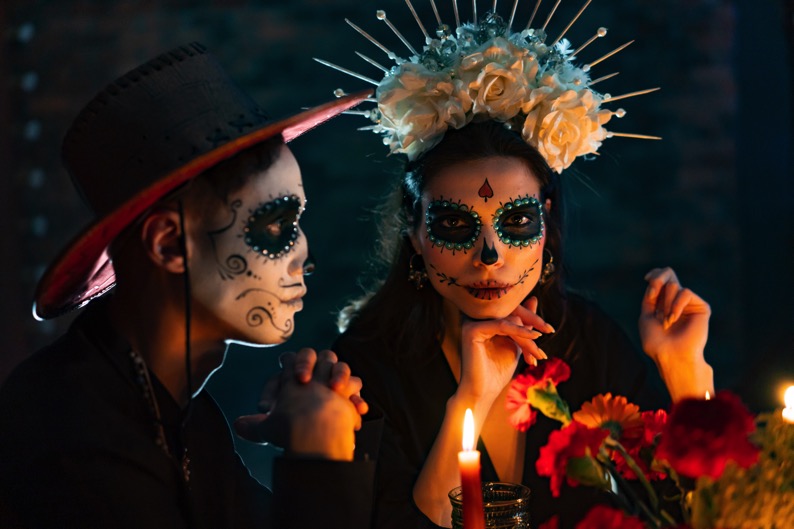El Día de los Muertos, also known as the Day of the Dead in English, is a holiday celebrated in several Latin American countries, including Bolivia, Peru, Ecuador, and Guatemala. It is especially important in Mexico, but it is also celebrated in the Philippines and Haiti.
The celebration was led by the ancient goddess Mictecacihuatl, known as the god of death in ancient Aztec religion, who was also one of the rulers of the Aztec underworld, Mictla, and lasted a month. After Spanish colonizers arrived in Mexico in 1519 and attempted to suppress indigenous religious practice while converting native peoples to Roman Catholicism, the holiday was moved to coincide with All Saints’ Day and All Souls’ Day, which fall on November 1st and 2nd, respectively.
El Día de los Muertos, as we know it today, is a day set aside to honor and remember loved ones who have died, allowing people to come together to remember and celebrate the lives of those who are no longer with us. It is a joyful and colorful celebration with a much lighter tone, and it is portrayed as a holiday of joy rather than mourning. Processions, altars in their family homes, and altars built at the graves of their deceased loved ones, decorated with sugar skulls, flowers, candles, photographs of the deceased, personal items that used to belong to the deceased, traditional Mexican music, food, and favorite drinks of the deceased, are also prepared as offerings.
People take to the streets in Mexico’s cities and towns to participate in local festivals and events that include music and entertainment as part of their Day of the Dead celebrations. There are musicians and dancers performing in the streets, plazas, and other public spaces, adding to the festive atmosphere and encouraging the consumption of food and alcohol.
The holiday has a festive atmosphere with colorful decorations, music, dancing, and parades. People frequently paint their faces as skeletons or skulls and dress in traditional attire.
The use of wooden skulls or even decorative wooden masks could be a creative and artistic interpretation of the holiday. People in Mexico and those of Mexican descent often display a wide range of artistic expressions during Day of the Dead, and creativity in celebrating the holiday is encouraged.
As you can see, Día de los Muertos in Mexico is more than just a holiday; it is a cultural experience, a vibrant and culturally significant tradition. It is a beautiful and rich cultural experience that has gained recognition and popularity outside of Mexico’s borders, with celebrations and observances taking place all over the world. Indeed, it is one of the most unique experiences in Mexico, and Unesco designated it as an intangible world heritage of humanity in 2008.
Mexico City
Mexico was the first country to celebrate Día de los Muertos, or Day of the Dead. These celebrations began when Mexicans believed that mourning and sadness would offend the dead. As a result, an annual commemoration was established to honor the dead as a day separate from the grief of funerals, memorials, and wakes.
There are two locations in Mexico City that best represent Día de los Muertos. The Day of the Dead is the most important celebration in San Andres Mixquic, a community southeast of Mexico City. In fact, the village and its church have become famous for the tradition, which is often planned two to three months in advance. The graves are adorned with brightly colored marigolds, and the cemetery is illuminated by hundreds of glowing candles. The city is bursting at the seams with street stalls, household altars, and parades down the street.
In Mexico City, Xochimilco’s canals and chinampas host a special Day of the Dead boat tour after the sun sets.
On the first of November, Spanish people also observe “El Día de los Muertos” as “El Día de todos los Santos” when they visit family graves to clean them, place new flowers, and pray for their souls.
As we celebrate this special festival, may we never forget that death is not the end. There is so much beauty and excitement in the afterlife. All of us at Ya-Hub Translations wish you a happy Day of the Dead.

